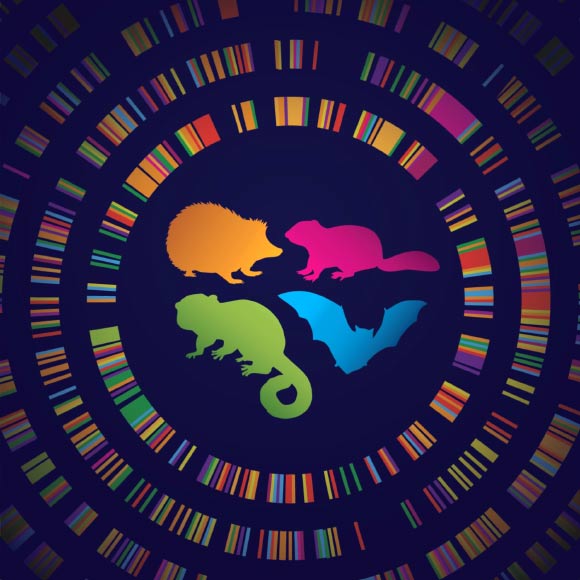Two new studies by University of Utah researchers provide clues on how to unlock these hibernating abilities, opening the door to someday developing treatments that could reverse neurodegeneration and diabetes.
Studying the evolution of hibernators like some hedgehogs, bats, ground squirrels, and lemurs could reveal the secrets of their remarkable resilience. Image credit: Chrissy Richards.
A gene cluster called the fat mass and obesity (FTO) locus plays an important role in hibernators’ abilities. Intriguingly, humans have these genes too.
“What’s striking about this region is that it is the strongest genetic risk factor for human obesity,” said University of Utah’s Professor Chris Gregg, senior author on both studies.
“But hibernators seem able to use genes in the FTO locus in new ways to their advantage.”
Professor Gregg and his colleagues identified hibernator-specific DNA regions that are near the FTO locus and that regulate the activity of neighboring genes, tuning them up or down.
They speculate that adjusting the activity of neighboring genes, including those in or near the FTO locus, allows hibernators to pack on the pounds before settling in for the winter, then slowly use their fat reserves for energy throughout hibernation.
Indeed, the hibernator-specific regulatory regions outside of the FTO locus seem crucial for tweaking metabolism.
When the researchers mutated those hibernator-specific regions in mice, they saw changes in the mice’s weight and metabolism.
Some mutations sped up or slowed down weight gain under specific dietary conditions; others affected the ability to recover body temperature after a hibernation-like state or tuned overall metabolic rate up or down.
Intriguingly, the hibernator-specific DNA regions the researchers identified weren’t genes themselves.
Instead, the regions were DNA sequences that contact nearby genes and turn their expression up or down, like an orchestra conductor fine-tuning the volume of many musicians.
“This means that mutating a single hibernator-specific region has wide-ranging effects extending far beyond the FTO locus,” said University of Utah’s Dr. Susan Steinwand, first author on the first study.
“When you knock out one of these elements — this one tiny, seemingly insignificant DNA region — the activity of hundreds of genes changes. It’s pretty amazing.”
Understanding hibernators’ metabolic flexibility could lead to better treatments for human metabolic disorders like type 2 diabetes.
“If we could regulate our genes a bit more like hibernators, maybe we could overcome type 2 diabetes the same way that a hibernator returns from hibernation back to a normal metabolic state,” said University of Utah’s Dr. Elliott Ferris, first author on the second study.
Finding the genetic regions that may enable hibernation is a problem akin to excavating needles from a massive DNA haystack.
To narrow down the regions involved, the scientists used multiple independent whole-genome technologies to ask which regions might be relevant for hibernation.
Then, they started looking for overlap between the results from each technique.
First, they looked for sequences of DNA that most mammals share but that had recently changed in hibernators.
“If a region doesn’t change much from species to species for over 100 million years but then changes rapidly and dramatically in two hibernating mammals, then we think it points us to something that is important for hibernation, specifically,” Dr. Ferris said.
To understand the biological processes that underlie hibernation, the researchers tested for and identified genes that turn up or down during fasting in mice, which triggers metabolic changes similar to hibernation.
Next, they found the genes that act as central coordinators, or hubs, of these fasting-induced changes to gene activity.
Many of the DNA regions that had recently changed in hibernators also appeared to interact with these central coordinating hub genes.
Because of this, the authors expect that the evolution of hibernation requires specific changes to the controls of the hub genes.
These controls comprise a shortlist of DNA elements that are avenues for future investigation.
Most of the hibernator-associated changes in the genome appeared to break the function of specific pieces of DNA, rather than confer a new function.
This hints that hibernators may have lost constraints that would otherwise prevent extreme flexibility in the ability to control metabolism.
In other words, it’s possible that the human thermostat is locked to a narrow range of continuous energy consumption. For hibernators, that lock may be gone.
Hibernators can reverse neurodegeneration, avoid muscle atrophy, stay healthy despite massive weight fluctuations, and show improved aging and longevity.
The researchers think their findings show that humans may already have the needed genetic code to have similar hibernator-like superpowers — if we can bypass some of our metabolic switches.
“Humans already have the genetic framework,” Dr. Steinwand said.
“We just need to identify the control switches for these hibernator traits.”
“By learning how, researchers could help confer similar resilience to humans.”
“There’s potentially an opportunity — by understanding these hibernation-linked mechanisms in the genome — to find strategies to intervene and help with age-related diseases,” Professor Gregg said.
“If that’s hidden in the genome that we’ve already got, we could learn from hibernators to improve our own health.”
The results appear in two paper in the journal Science.
_____
Susan Steinwand et al. 2025. Conserved noncoding cis elements associated with hibernation modulate metabolic and behavioral adaptations in mice. Science 389 (6759): 501-507; doi: 10.1126/science.adp4701
Elliott Ferris et al. 2025. Genomic convergence in hibernating mammals elucidates the genetics of metabolic regulation in the hypothalamus. Science 389 (6759): 494-500; doi: 10.1126/science.adp4025
